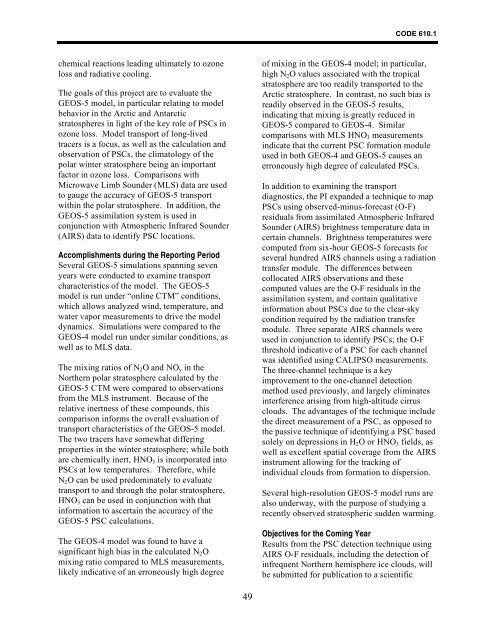We're Number 1! - Goddard Earth Sciences & Technology Center ...
We're Number 1! - Goddard Earth Sciences & Technology Center ...
We're Number 1! - Goddard Earth Sciences & Technology Center ...
Create successful ePaper yourself
Turn your PDF publications into a flip-book with our unique Google optimized e-Paper software.
chemical reactions leading ultimately to ozone<br />
loss and radiative cooling.<br />
The goals of this project are to evaluate the<br />
GEOS-5 model, in particular relating to model<br />
behavior in the Arctic and Antarctic<br />
stratospheres in light of the key role of PSCs in<br />
ozone loss. Model transport of long-lived<br />
tracers is a focus, as well as the calculation and<br />
observation of PSCs, the climatology of the<br />
polar winter stratosphere being an important<br />
factor in ozone loss. Comparisons with<br />
Microwave Limb Sounder (MLS) data are used<br />
to gauge the accuracy of GEOS-5 transport<br />
within the polar stratosphere. In addition, the<br />
GEOS-5 assimilation system is used in<br />
conjunction with Atmospheric Infrared Sounder<br />
(AIRS) data to identify PSC locations.<br />
Accomplishments during the Reporting Period<br />
Several GEOS-5 simulations spanning seven<br />
years were conducted to examine transport<br />
characteristics of the model. The GEOS-5<br />
model is run under “online CTM” conditions,<br />
which allows analyzed wind, temperature, and<br />
water vapor measurements to drive the model<br />
dynamics. Simulations were compared to the<br />
GEOS-4 model run under similar conditions, as<br />
well as to MLS data.<br />
The mixing ratios of N2O and NOy in the<br />
Northern polar stratosphere calculated by the<br />
GEOS-5 CTM were compared to observations<br />
from the MLS instrument. Because of the<br />
relative inertness of these compounds, this<br />
comparison informs the overall evaluation of<br />
transport characteristics of the GEOS-5 model.<br />
The two tracers have somewhat differing<br />
properties in the winter stratosphere; while both<br />
are chemically inert, HNO3 is incorporated into<br />
PSCs at low temperatures. Therefore, while<br />
N2O can be used predominately to evaluate<br />
transport to and through the polar stratosphere,<br />
HNO3 can be used in conjunction with that<br />
information to ascertain the accuracy of the<br />
GEOS-5 PSC calculations.<br />
The GEOS-4 model was found to have a<br />
significant high bias in the calculated N2O<br />
mixing ratio compared to MLS measurements,<br />
likely indicative of an erroneously high degree<br />
49<br />
CODE 610.1<br />
of mixing in the GEOS-4 model; in particular,<br />
high N2O values associated with the tropical<br />
stratosphere are too readily transported to the<br />
Arctic stratosphere. In contrast, no such bias is<br />
readily observed in the GEOS-5 results,<br />
indicating that mixing is greatly reduced in<br />
GEOS-5 compared to GEOS-4. Similar<br />
comparisons with MLS HNO3 measurements<br />
indicate that the current PSC formation module<br />
used in both GEOS-4 and GEOS-5 causes an<br />
erroneously high degree of calculated PSCs.<br />
In addition to examining the transport<br />
diagnostics, the PI expanded a technique to map<br />
PSCs using observed-minus-forecast (O-F)<br />
residuals from assimilated Atmospheric Infrared<br />
Sounder (AIRS) brightness temperature data in<br />
certain channels. Brightness temperatures were<br />
computed from six-hour GEOS-5 forecasts for<br />
several hundred AIRS channels using a radiation<br />
transfer module. The differences between<br />
collocated AIRS observations and these<br />
computed values are the O-F residuals in the<br />
assimilation system, and contain qualitative<br />
information about PSCs due to the clear-sky<br />
condition required by the radiation transfer<br />
module. Three separate AIRS channels were<br />
used in conjunction to identify PSCs; the O-F<br />
threshold indicative of a PSC for each channel<br />
was identified using CALIPSO measurements.<br />
The three-channel technique is a key<br />
improvement to the one-channel detection<br />
method used previously, and largely eliminates<br />
interference arising from high-altitude cirrus<br />
clouds. The advantages of the technique include<br />
the direct measurement of a PSC, as opposed to<br />
the passive technique of identifying a PSC based<br />
solely on depressions in H2O or HNO3 fields, as<br />
well as excellent spatial coverage from the AIRS<br />
instrument allowing for the tracking of<br />
individual clouds from formation to dispersion.<br />
Several high-resolution GEOS-5 model runs are<br />
also underway, with the purpose of studying a<br />
recently observed stratospheric sudden warming.<br />
Objectives for the Coming Year<br />
Results from the PSC detection technique using<br />
AIRS O-F residuals, including the detection of<br />
infrequent Northern hemisphere ice clouds, will<br />
be submitted for publication to a scientific


